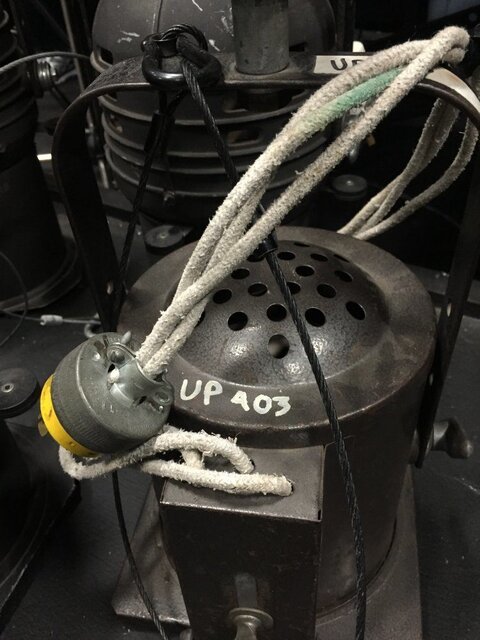I worked my way through school as a boiler operating school custodian. Working around asbestos was a daily thing and I had a lot of training so I knew what to do and what not to do. Asbestos is bad stuff but only when it turns friable and breaks down into little tiny particles and gets in your lungs. The nasty thing about asbestos is that the particles are so small that they don't fall to the ground. They will stay airborne in a closed room for days. When you walk past you stir them right back up again. Asbestos still in its original fiber form is completely harmless.
Should you be afraid if you see a little asbestos wiring in a theater? No. Should you try to do something about it? Well yes of course, but not for fear of the audience all dying next week. Asbestos is a prolonged exposure killer. It's the lighting technician who works with these instruments all the time who is at the highest risk here. When soaking wet, asbestos is completely harmless. Your concern is tiny particles floating into the smallest corners of your lungs and staying forever. This isn't possible when asbestos is properly sealed off, still in good condition, or wet. As Ship said, you should really be more worried about the particles in the dust on the floor.
Asbestos was a wonder product and it is EVERYWHERE. I would be far more concerned about the safety of the sound proofing in the building, the tile floor, the material the ceiling is made from. They are also likely to be asbestos and far more dangerous. Do you have "popcorn" ceilings at home? Ever work for a brake shop? Bad news brake pads are loaded with the stuff. It's everywhere. Here in Seattle they were doing air purity testing inside schools and they were testing one school located very close to the freeway during rush hour traffic. It's an old school full of asbestos but (due to the slow grinding stop and go rush hour traffic outside) there was actually more asbestos in the outdoor control samples than inside the building.
There are lots of federal laws covering proper disposal of asbestos. I doubt it's legal to just cut off the whips, bag them and throw them in the trash. At the same time this potentially opens a HUGE can of worms. Once you start down the asbestos removal path it gets REALLY expensive REALLY fast. I think just about every building you've ever been in built before the 1980's could be shut down for asbestos if someone really put their mind to it.
Yes it's a problem.
Yes it should be removed from theaters.
No don't call 911.
As Awhaley said consult an actual expert before panicking.
Work with the theater to develop a solution of how to gradually replace the cables.
Should you be afraid if you see a little asbestos wiring in a theater? No. Should you try to do something about it? Well yes of course, but not for fear of the audience all dying next week. Asbestos is a prolonged exposure killer. It's the lighting technician who works with these instruments all the time who is at the highest risk here. When soaking wet, asbestos is completely harmless. Your concern is tiny particles floating into the smallest corners of your lungs and staying forever. This isn't possible when asbestos is properly sealed off, still in good condition, or wet. As Ship said, you should really be more worried about the particles in the dust on the floor.
Asbestos was a wonder product and it is EVERYWHERE. I would be far more concerned about the safety of the sound proofing in the building, the tile floor, the material the ceiling is made from. They are also likely to be asbestos and far more dangerous. Do you have "popcorn" ceilings at home? Ever work for a brake shop? Bad news brake pads are loaded with the stuff. It's everywhere. Here in Seattle they were doing air purity testing inside schools and they were testing one school located very close to the freeway during rush hour traffic. It's an old school full of asbestos but (due to the slow grinding stop and go rush hour traffic outside) there was actually more asbestos in the outdoor control samples than inside the building.

There are lots of federal laws covering proper disposal of asbestos. I doubt it's legal to just cut off the whips, bag them and throw them in the trash. At the same time this potentially opens a HUGE can of worms. Once you start down the asbestos removal path it gets REALLY expensive REALLY fast. I think just about every building you've ever been in built before the 1980's could be shut down for asbestos if someone really put their mind to it.
Yes it's a problem.
Yes it should be removed from theaters.
No don't call 911.
As Awhaley said consult an actual expert before panicking.
Work with the theater to develop a solution of how to gradually replace the cables.



